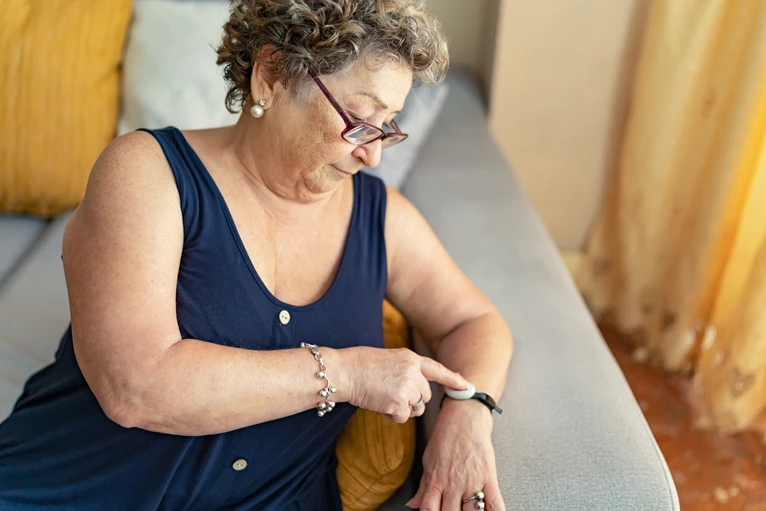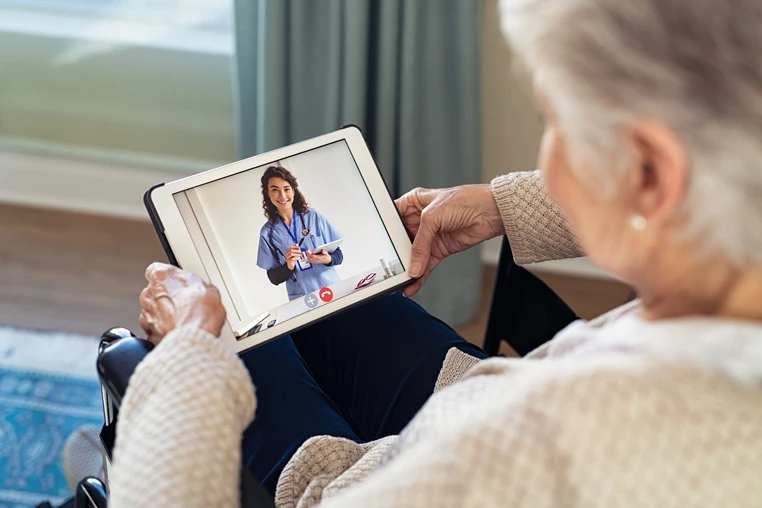Assistive Technology - What You Need to Know
Assistive technology (AT) has transformed the way care services support people with age-related conditions and disabilities. These assistive technologies are beginning to play a crucial role in care homes, as they enhance the quality of life for residents, promote independence and improve overall health and wellbeing. From helping people living with dementia maintain cognitive function, to aiding those with physical impairments to perform daily tasks, assisted technology offers a wide range of solutions.
The Access Group have been supporting care services across the world for over 30 years through digitisation. We know more than most about the fantastic impact technology can have on a business and how it can save time, money, space and resources in the long run.
As the use and development of assistive technology increases, we thought it would be a great idea to put together this comprehensive guide, so you can gain a better understanding of these devices and learn how they can improve the lives of your service users. We will take a closer look at the importance of assistive technology in care homes and provide examples of assistive technology being utilised to address a variety of needs.
What is Assistive Technology?
Assistive technology refers to any equipment, system or device that helps individuals with age-related conditions and/or disabilities to increase their mobility, access information, perform tasks and communicate effectively. Assistive technologies have been designed to bridge the gap between the abilities of individuals and the demands of their environment, which will empower them to take part in daily life activities more fully.
Assistive Technology Examples
Examples of assistive technology include anything from a simple pair of glasses to help the visually impaired read a book to a more complex speech-to-text software to aid people with communication difficulties. Here are some assistive technology examples for specific age-related conditions and disabilities that you could consider and implement in your care home. While some of these examples may not apply to your care service, they are here to give you a better understanding of AT and how it can help and support various people in many ways.
1. Assistive Technology for Communication
As people get older, they may struggle with communication. This can impact their ability to express themselves, how they interact with others and how they engage in social situations. The solution is augmentative and alternative communication (AAC) devices. These can be used to support people who have limited to no speech. They can range from basic picture boards to high-tech, speech-generating technologies that can translate gestures or symbols into spoken words. This gives people the opportunity to communicate their thoughts, needs and feelings successfully.
2. Assistive Technology for Dementia
Dementia is a progressive condition that affects the cognitive abilities, memory and behaviour of individuals. AT can help improve the lives of people living with dementia and provide significant support to their caregivers. For example, electronic memory aids which include digital calendars and reminder systems, can help people to remember important information such as appointments or daily tasks. Then there are GPS tracking devices. These can be used to ensure the safety of individuals who often wander, which will provide peace of mind for care staff and loved ones.
3. Assistive Technology for Visual Impairment
It’s common for people to lose their sight as they age. This can be anything from long-sightedness to limited vision due to a disease, like cataracts. Visual impairments can lead to challenges regarding navigating their environment, accessing information and independence. Assistive technologies to tackle this include braille displays, screen readers and magnification software. These allow people with sight issues to read and access digital content and online resources, and interact with computers. There are also electronic travel aids, such as handheld devices with GPS and audio feedback, which can assist people in independently navigating their environment and surroundings.
4. Assistive Technology for Learning Disabilities
People with learning disabilities are presented with challenges in everyday settings and situations, even in care homes during later life. Assistive technology has been developed to assist individuals with learning disabilities in areas such as organisations, reading and writing. Text-to-speech software is a great example, as it can read written information aloud which makes it more accessible to those who find it hard to read. Another example is mind-mapping tools. These can be used to help people organise their routines, ideas and thoughts in a visual, structured way.
5. Assistive Technology for Autism
Autism spectrum disorders impact social interaction, communication and sensory processing. Assistive technology can be used to offer support to people with autism and include visual schedules and social stories. These can be presented on smartphones or tablets to help individuals navigate and understand daily routines. Sensory integration tools, like weighted blankets or sensory-friendly apps, can help people living with autism manage sensory activities while promoting relaxation.
6. Assistive Technology for Cerebral Palsy
Cerebral palsy is a group of disorders that can affect an individual's ability to maintain balance and posture and move around independently. Assistive technology for cerebral palsy includes mobility aids such as walkers, wheelchairs and specialised seating systems. Then there are communication devices that have switches or eye-tracking technology to help individuals express themselves if they find it hard to speak. There are also robotic exoskeletons and orthotic devices that can be used to assist movement and therapy. While there is no cure, the right care and the use of AT can promote independence.
7. Assistive Technology Devices for Elderly
When individuals age, they may come across cognitive, sensory and mobility limitations that impact their quality of life. Assistive technology devices for elderly people can be used to help them maintain independence and comfort while improving their quality of life. Examples include medication management devices, fall detection and emergency alert systems and adaptive utensils. We will go into more detail on various assistive technology in care homes below.

Examples of Assistive Technology in Care Homes
Assistive technology consists of a range of electronic aids that can be used to help people live independently, but can also alert a carer if a problem occurs. Some technology enables people in need of care and support to feel more confident being alone which can ease pressure on the need for carers. Here are some examples of assistive technology in care homes:
- Adaptive utensils and assistive devices for eating – Older people with mobility issues or dexterity may struggle to eat independently. Adaptive utensils, like weighted or angled utensils, make it easier for them to grasp and manoeuvre food. Other assistive devices such as plate guards, specialised cups and non-slip mats can also improve eating abilities.
- Fall detection and emergency alert systems – Falls can have devastating effects on older adults. Fortunately, assistive technology can mitigate risks. Fall detection systems use wearable devices or sensors to detect falls and will automatically alert the caregiver or emergency services. There are also emergency alert systems that allow older people to call for help by pushing a button.
- Hearing aids and amplification devices – Hearing loss is common amongst elderly people. Hearing aids and amplification devices can be used to improve their communication and overall engagement with their environment. They have been designed to amplify sound and enhance speech clarity, making it easier for people to communicate and engage in conversations.
- Medication management devices - These can be used by older adults to keep on top of their medication schedules and to ensure they take the right medication at the right time. They often include features such as automatic pill dispensers with alarms, electronic medication organisers and reminder apps.
- Personal emergency response systems – Consist of wearable devices or systems that allow older people to call for help during emergencies, such as a fall or medical event. They often include features like GPS tracking, automatic fall detection and two-way communication to ensure prompt assistance when it’s needed.
- Smart home systems – These consist of sensors and automation to control a variety of aspects within a home environment, including temperature, security and lighting. These can be voice-activated or controlled through smartphones, making it easier for elderly people to perform daily tasks and manage their living spaces.
Implementing Assistive Technology in Care Homes
Several key considerations must be taken into account if you want to successfully implement assistive technology in care homes. Here are 4 things you should consider:
1. Individual Assessment
Each resident should have their needs and abilities assessed to determine which assistive technology solution would be most appropriate for their specific requirements. A person-centred approach will ensure that the technology/technologies that have been chosen are tailored to each person and align with their preferences and goals.
2. Training and Support
Both service users and care home employees will need to receive the right training and ongoing support to ensure continued and effective use of the assistive technologies introduced in the care home. Training programs must cover information surrounding maximising the benefits of the technology, device operation and troubleshooting common problems. On top of this, technical support resources should be made readily available so any future difficulties or concerns are addressed.
3. Accessibility and Usability
Assistive technology should be designed with usability and accessibility in mind. User interfaces should be insightful and intuitive, and devices should be able to adapt to accommodate different cognitive and physical abilities. Other features should include adjustable settings, clear instructions, large buttons and compatibility with other devices or software. These all impact the overall usability of the technology.
4. Regular Evaluation and Updates
Technology is constantly improving and advancing, so you should evaluate the effectiveness of the assistive technology you use often and consider replacements or updates when necessary. Care homes need to make sure that they stay well-informed and up-to-date when it comes to new developments in the world of assistive technology. They should also be open to exploring how emerging solutions can be used to benefit their service users even further.

Assisted Technology for You
Assistive technology has the potential to enhance the lives of many people in care homes by promoting independence, improving communication, and addressing specific age-related challenges and disabilities. When the vast and diverse range of assistive technologies is implemented and embraced, care homes will be able to create an inclusive environment that can empower their residents, enhance their quality of life and enable them to thrive.
The world of assistive technology is now changing rapidly, you and the people you care for can benefit from being at the forefront of this change. New and improved sensors, health monitoring devices (including ‘wearables’) and smart appliances all generate enormous amounts of data on people’s movement, mobility, behaviour, habits and so on.
On its own, this data can be overwhelming and not much use. But now machine learning and artificial intelligence advancements mean the data can be used in a meaningful way, really for the first time. Practically, this means that, for example, you and your team can be proactively alerted to signals of an adverse health event in any individual. This means you can make interventions earlier, meaning the chance of a negative impact on people’s health and well-being is reduced.
Being able to track habits, behaviour and movements also enables much more detailed tracking of outcomes with a more robust evidence base. This is a real revolution when it comes to building and demonstrating increased independence, whether in older people or for people with learning disabilities or autism spectrum disorders and other conditions.
Access Assure is a digital telecare software enabling care providers in both residential and community settings to make this leap forward in care provision now. Assure comes with a home hub that brings together all the data from for example, sensors on their doors, smart plugs and so on, with an app that tracks their daily behaviours, so you can be notified if there is an unusual change in someone’s routine.
Assure’s recent integration with our care planning solution also enables carers to have the visibility of smart alerts and alarms within our care planning app so all the information needed is centralised in one place to help deliver better proactive person-centred care. This, in turn, helps to reduce risks and identify issues before they occur by having more enhanced activity information between visits to fully understand what has happened in the home before they even arrive.
This software essentially brings together reactive alarms and preventative care, so alerts can be sent out before something more serious takes place. It can also be used to provide reassurance to families and loved ones, reduce hospital admissions and delay care needs, as older people can restore and maintain their independence, either at home or at their care home. If you would be interested in implementing our technology-enabled care, feel free to contact us today to find out more information.



